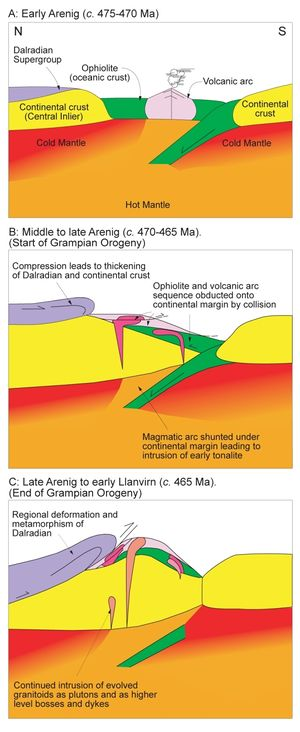Deformation and regional metamorphism of the Dalradian, Northern Ireland
| Mitchell, W I (ed.). 2004. The geology of Northern Ireland-our natural foundation. Geological Survey of Northern Ireland, Belfast. |
M R Cooper and T P Johnston
Deformation of the Dalradian


The Dalradian rocks in Northern Ireland were intensely deformed and metamorphosed during the Grampian Orogeny (P947796). At least four separate phases of deformation and associated structures are recognised in the Dalradian rocks in Northern Ireland. Folds and cleavages resulting from the earliest deformation (D1) are, at best, barely discernible and are generally obscured in a composite fabric defined by bedding surfaces (Ss) and the sub-parallel first schistosity (S1). D2 was the dominant deformation of the Grampian Orogeny in Northern Ireland and was associated with the formation of major regional southeast-facing recumbent anticlines, the Sperrin Fold in the Sperrin Mountains and the Altmore Anticline in northeast Co. Antrim. These structures are analogous to the Tay Nappe in Scotland, which formed as a result of D2 flattening, tightening and extension of an earlier D1 anticline [1]. A penetrative schistosity, which developed throughout the southern part of the Sperrin Mountains and in northeast Co. Antrim, strongly crenulates the earlier formed composite Ss/S1 surfaces.
In the south Sperrin Mountains, the D3 deformation resulted in southeasterly-verging minor folds and a number of low-angle, northwards inclined thrust surfaces such as the Omagh Thrust Fault, which transported Dalradian rocks to the SSE over the early Ordovician Tyrone Igneous Complex [2]. In west Co. Tyrone and central and south Co. Donegal the Ballybofey Nappe is the dominant D3 structure controlling the disposition of Dalradian strata (P947792). This sub-recumbent structure closes and faces towards the southeast and is disrupted by several northeast-trending late Caledonian faults [3]. The lowest structural levels of the Dalradian succession in west Co. Tyrone are in tectonic contact with the Lough Derg Group along the Lough Derg Slide [4], [5].
Post- D3 structures in Northern Ireland mainly take the form of localised sets of kink bands and late stage brittle fractures.
Regional metamorphism
The pattern of regional metamorphism in the Dalradian Supergroup in Northern Ireland reflects a thermal and pressure gradient increasing from lower greenschist facies in the north to lower amphibolite facies in the south, close to the Omagh Thrust Fault [6]. Metamorphic minerals including albite, muscovite, biotite, epidote, chlorite and actinolite occur throughout a large part of the Sperrin Mountains and are indicative of greenschist facies metamorphism. However, in the southern part of the Sperrin Mountains and in the Lack Inlier, garnet (almandine) porphyroblasts are indicative of slightly higher grade metamorphism in the upper greenschist to lower amphibolite facies. The garnets commonly have chloritic alteration rims indicating a later retrogressive phase possibly linked to late Caledonian movements on the Omagh Thrust Fault.
References
- ↑ Stephenson, D, and Gould, D. 1995. British regional geology: the Grampian Highlands (4th edition). (London: HMSO for the British Geological Survey).
- ↑ Alsop, G I, and Hutton, D H W. 1993. Major southeast-directed Caledonian thrusting and folding in the Dalradian rocks of mid-Ulster: Implications for Caledonian tectonics and mid-crustal shear zones. Geological Magazine. 130, 233–44.
- ↑ Alsop, G I. 1991. Gravitational collapse and extension along a mid-crustal detachment: the Lough Derg Slide, north-west Ireland. Geological Magazine. 128, 345–54
- ↑ Alsop, G I, and Hutton, D H W. 1990. A review and revision of Dalradian stratigraphy in central and southern Donegal, Ireland. Irish Journal of Earth Sciences. 10, 181–98.
- ↑ Geological Survey of Northern Ireland, 1994. Kesh, Northern Ireland Sheet 32. Solid Geology. 1:50 000. (Keyworth, Nottingham: British Geological Survey).
- ↑ Hartley, J J. 1938. The Dalradian rocks of the Sperrin Mountains and adjacent areas in Northern Ireland. Proceedings of the Royal Irish Academy. 44B, 141–71.